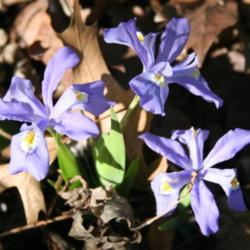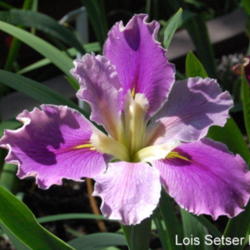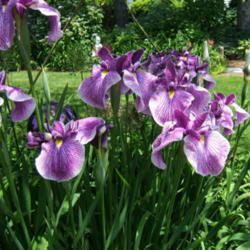There are woodland dwellers, such as Iris cristata, which thrive in dappled shade. There are the moisture lovers and "swamp Irises," which can be useful in poorly drained sites, or in moisture retentive soil, such as Japanese, Siberian, and Louisiana types, with many hybrids and colors available. There are Irises perfectly suited to xeriscape use, such as the Bearded and Spuria varieties that thrive in dry climates. The best thing about most of these groups is that they tolerate a variety of conditions outside their native habitat, performing happily under regular garden conditions. Irises occur in practically every color, except true red (although some are very close). It is very appropriate that Iris is the name of the Greek goddess who is the personification of the rainbow.
Ornamental gardening with a great variety of flowering plants is my passion, so I've naturally amassed quite a collection of plants, without intending to be a "collector." The same is true of my irises, as there are so many that fit perfectly in such a variety of ways. Some of the first flowers in my garden in late winter and early spring are Iris reticulata cultivars, blooming alongside crocuses, snowdrops, and the first daffodils. In mid- spring cheerful clumps of dwarf bearded irises join daffodils, tulips, and hyacinths. By late spring the tall bearded irises are opening, along with the bleeding hearts, late tulips, dogwoods, and lilacs. Tall bearded irises are the stars of the show throughout late spring, accompanying peonies, columbines, and the first of the roses. There are thousands of registered bearded irises to choose from, including heirloom or "historic" varieties grown by our ancestors for hundreds or even thousands of years. In the bearded category alone, there are graceful and "wildflowery" varieties for the most natural landscapes, and the huge, showy, ruffled, and lacy blooms of many modern hybrids that say "look at me!" -- and everything in between, with sizes ranging from 4" to over 40" tall. While tall bearded varieties are going strong, Siberian irises come into full swing, and soon afterward they are joined by Louisiana and Spuria varieties. The Iris show here ends in early summer, with the exotic beauty of Japanese irises, in their glory with roses, lilies, and many perennials.
Furthermore, the show doesn’t necessarily end there; there are many modern cultivars of bearded irises, and some Siberian Irises, that are called “re-bloomers” as they are reported to have a second bloom cycle in late summer or fall under favorable growing conditions. As you can see, it is easy to amass quite a collection of Irises, without any intention of being an Iris collector. But be forewarned: They are easy to fall in love with, and they easily become an obsession.
Whether your gardening style is formal or casual, or your interests are native plants, water gardening, xeriscaping, rock gardens, or shade gardens, there is a perfect iris for your garden!





| Thread Title | Last Reply | Replies |
|---|---|---|
| Dutch iris? by TiaLee | May 16, 2015 11:31 AM | 1 |
| Excellent! by Zencat | May 13, 2015 3:41 PM | 2 |